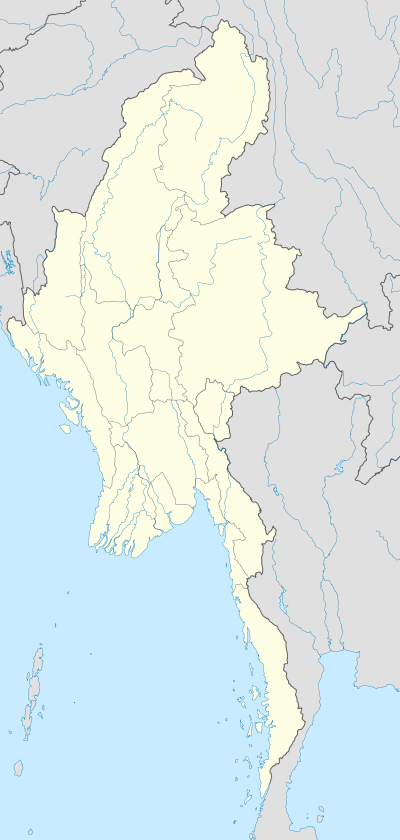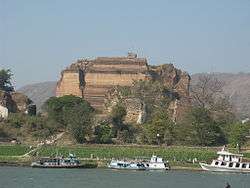Pahtodawgyi
| Pahtodawgyi | |
|---|---|
| ပုထိုးတေတာ္ျကီး | |
|
Pahtodawgi | |
 Shown within Myanmar | |
| Basic information | |
| Geographic coordinates | 21°54′41″N 96°03′23″E / 21.911432°N 96.056438°ECoordinates: 21°54′41″N 96°03′23″E / 21.911432°N 96.056438°E |
| Affiliation | Theravada Buddhism |
| Country | Amarapura, Mandalay Region, Burma |
| Architectural description | |
| Founder | King Bagyidaw |
| Completed | 1819 |
Pahtodawgyi (Burmese: ပုထိုးတေတာ္ျကီး) also known Mingun Paya (Paya means "pagoda") is a Buddhist pagoda which is partially built near the city of Sagaing in central Burma.[1] It was built by King Bodawpaya (1782-1819).[2] the longest reigning king of his Alaungpaya dynasty.[3]
Location
The Pahtodawgyi is located near the city of Sagaing, in Mandalay in central Burma.[4] It is at a distance of about 11 km from Mandalay by river transport on the opposite bank of the Ayeyarwaddy accessible only by river.[5]
History
King Bodawpaya of the Alaungpaya dynasty who ruled for the longest period from 1781 to 1819 was the builder this huge Mingun Pagoda, left incomplete.[2] He laid the foundation stone for the construction of this pagoda in 1790, over an old monastery, but it remained incomplete as Bodawpaya died in 1819. If it had been fully built it would have been the biggest pagoda in the world.[6][4]
During the earthquake of 1838 the edifice developed a few cracks which were further compounded during the earthquake of 2012. Hence climbing to the top of the pagoda is not permitted from safety considerations.[6]
Features
The pagoda, in white colour,[7] also known as Mahayvizya-ranthi Pagoda has a total dimension of 240 cubic feet (6.8 m3) cube built over lower terrace. The width of the pagoda at the base is 256 feet (78 m) square which is about 150 high to the tip of the tower. The amount of bricks used in its construction is said to be "the world's largest pile of bricks".[5][6][4] It has a marble Buddha at the base of which 108 auspicious symbols have been carved.[8] On the external faces at the base of the pagoda there are steles' depicting the theme of Buddha's past life. A vantage location to view the pagoda is from the U Bein Bridge across the Taung River.[7]The pagoda has similarity with the Shwedzigon Pagoda in Nyaung U, Pagan except that the three stepped terraces have marble sculptures related to the Jataka tales instead of the glazed terracotta tiles.[4]
During the reign of Bodawpaya had commissioned in 1808 a very huge bell made of bronze, known as the Mingun Bell for installation at the Pagoda. The bell measures 13 feet (4.0 m) in height and has a diameter of 16 feet (4.9 m) at its lip. It remained the world's biggest "ringable bell" for several decades till a bigger bell was installed at Pingdingshan in China. The bell is so large that one can go through beneath it.[6] It is hung on the northern part of the pagoda about 50 yards away from it. It weighs 90 tons and is today the second largest ringing bell in the world.[3][5]
References
- ↑ Mandalay 1910, p. 20.
- 1 2 Mandalay 1910, p. 8.
- 1 2 Burma 2001, p. 55.
- 1 2 3 4 Köllner Bruns1998, p. 170.
- 1 2 3 "The World's Three Largest Bells". Blagovest Bells. Retrieved 2007-03-15.
- 1 2 3 4 Richmond & Bush 2014, p. 543.
- 1 2 Courtauld 1999, p. 164.
- ↑ Ferrer 2014, p. 251.
Bibliography
- Burma, SEAMEO Regional Centre for History and Tradition Rangoon, (2001). Cultural classics. Universities Press.
- Courtauld, Caroline (1999). Burma (Myanmar). Odyssey. ISBN 978-962-217-608-9.
- Richmond, Simon; Bush, Austin; David Eimer, Mark Elliott, Nick Ray (1 June 2014). Lonely Planet Myanmar (Burma). Lonely Planet Publications. ISBN 978-1-74360-019-1. Cite uses deprecated parameter
|coauthors=(help) - List of Ancient Monuments in Burma (I. Mandalay Division). 1. Rangoon: Office of the Superintendent, Government Printing, Burma. 1910.
- Michel Ferrer (2014). Birmanie: Au pays des pagodes d'or. Editions Olizane. ISBN 978-2-88086-418-7.

